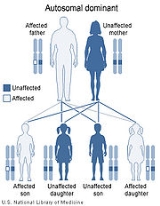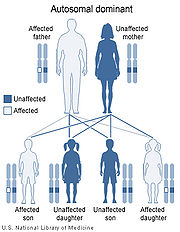
White sponge nevus
Encyclopedia
White sponge nevus also known as Cannon's disease, Hereditary leukokeratosis of mucosa and White sponge nevus of Cannon, is an autosomal
dominant skin condition. Although congenital
in most cases, it can first occur in childhood or adolescence.
, most frequently as a thick bilateral white plaque with a spongy texture, usually on the buccal mucosa, but sometimes on the labial
mucosa, alveolar ridge
or floor of the mouth. The gingival margin and dorsum of the tongue are almost never affected.
Although this condition is perfectly benign
, it is often mistaken for leukoplakia
. There is no treatment, but because there are no serious clinical complications, the prognosis is excellent.
 WSN is caused by a mutation of the keratin 4
WSN is caused by a mutation of the keratin 4
or keratin 13
genes, located respectively at human chromosome
s 12q13
and 17q21-q22
. The condition is inherited in an autosomal dominant manner. This indicates that the defective gene responsible for a disorder is located on an autosome
(chromosomes 12 and 17 are autosomes), and only one copy of the defective gene is sufficient to cause the disorder, when inherited from a parent who has the disorder.
Autosome
An autosome is a chromosome that is not a sex chromosome, or allosome; that is to say, there is an equal number of copies of the chromosome in males and females. For example, in humans, there are 22 pairs of autosomes. In addition to autosomes, there are sex chromosomes, to be specific: X and Y...
dominant skin condition. Although congenital
Congenital disorder
A congenital disorder, or congenital disease, is a condition existing at birth and often before birth, or that develops during the first month of life , regardless of causation...
in most cases, it can first occur in childhood or adolescence.
Characteristics
It presents in the mouthMouth
The mouth is the first portion of the alimentary canal that receives food andsaliva. The oral mucosa is the mucous membrane epithelium lining the inside of the mouth....
, most frequently as a thick bilateral white plaque with a spongy texture, usually on the buccal mucosa, but sometimes on the labial
Lip
Lips are a visible body part at the mouth of humans and many animals. Lips are soft, movable, and serve as the opening for food intake and in the articulation of sound and speech...
mucosa, alveolar ridge
Alveolar ridge
An alveolar ridge is one of the two jaw ridges either on the roof of the mouth between the upper teeth and the hard palate or on the bottom of the mouth behind the lower teeth. The alveolar ridges contain the sockets of the teeth....
or floor of the mouth. The gingival margin and dorsum of the tongue are almost never affected.
Although this condition is perfectly benign
Benign
A benign tumor is a tumor that lacks the ability to metastasize. Common examples of benign tumors include moles and uterine fibroids.The term "benign" implies a mild and nonprogressive disease. Indeed, many kinds of benign tumors are harmless to human health...
, it is often mistaken for leukoplakia
Leukoplakia
Leukoplakia is a clinical term used to describe patches of keratosis. It is visible as adherent white patches on the mucous membranes of the oral cavity, including the tongue, but also other areas of the gastro-intestinal tract, urinary tract and the genitals. The clinical appearance is highly...
. There is no treatment, but because there are no serious clinical complications, the prognosis is excellent.
Cause and genetics

Keratin 4
Keratin, type I cytoskeletal 4 also known as cytokeratin-4 or keratin-4 is a protein that in humans is encoded by the KRT4 gene....
or keratin 13
Keratin 13
Keratin 13 is a protein that in humans is encoded by the KRT13 gene.Keratin 13 is a type I cytokeratin, it is paired with keratin 4 and found in the suprabasal layers of non-cornified stratified epithelia...
genes, located respectively at human chromosome
Chromosome
A chromosome is an organized structure of DNA and protein found in cells. It is a single piece of coiled DNA containing many genes, regulatory elements and other nucleotide sequences. Chromosomes also contain DNA-bound proteins, which serve to package the DNA and control its functions.Chromosomes...
s 12q13
Chromosome 12 (human)
Chromosome 12 is one of the 23 pairs of chromosomes in humans. People normally have two copies of this chromosome. Chromosome 12 spans about 143 million base pairs and represents between 4 and 4.5 percent of the total DNA in cells.Identifying genes on each chromosome is an active area of genetic...
and 17q21-q22
Chromosome 17 (human)
125px|rightChromosome 17 is one of the 23 pairs of chromosomes in humans. People normally have two copies of this chromosome. Chromosome 17 spans more than 81 million base pairs and represents between 2.5 and 3 % of the total DNA in cells.Identifying genes on each chromosome is an active area of...
. The condition is inherited in an autosomal dominant manner. This indicates that the defective gene responsible for a disorder is located on an autosome
Autosome
An autosome is a chromosome that is not a sex chromosome, or allosome; that is to say, there is an equal number of copies of the chromosome in males and females. For example, in humans, there are 22 pairs of autosomes. In addition to autosomes, there are sex chromosomes, to be specific: X and Y...
(chromosomes 12 and 17 are autosomes), and only one copy of the defective gene is sufficient to cause the disorder, when inherited from a parent who has the disorder.

